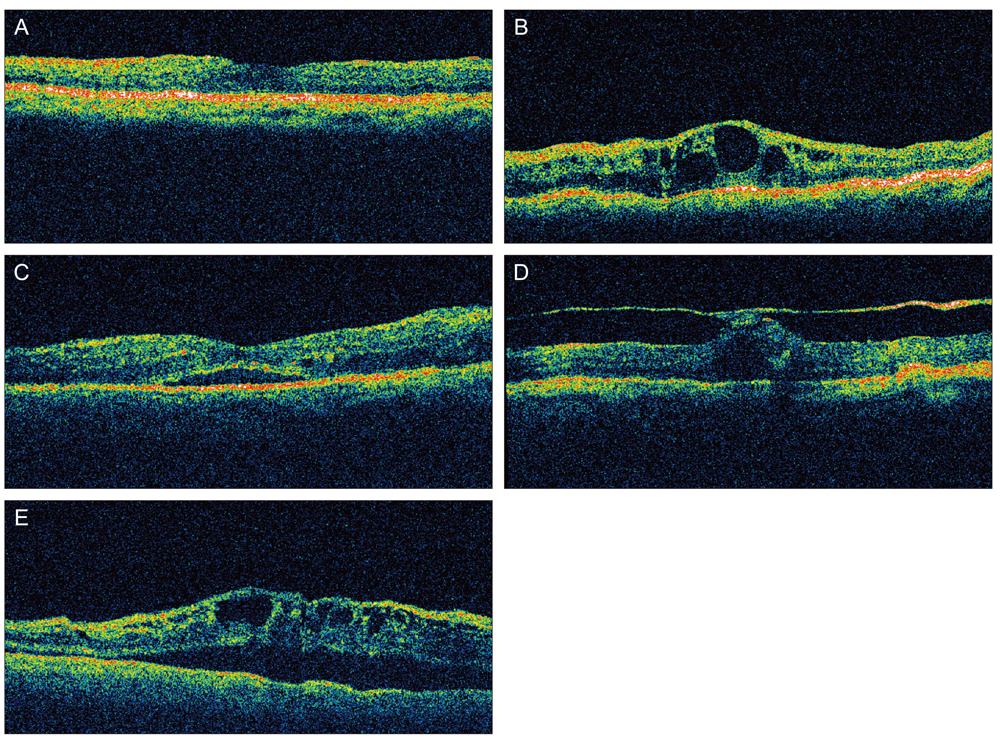Korean J Ophthalmol.
2013 Apr;27(2):98-102. 10.3341/kjo.2013.27.2.98.
Relationship between the Morphology of Diabetic Macular Edema and Renal Dysfunction in Diabetes
- Affiliations
-
- 1Department of Ophthalmology, Dongsan Medical Center, Keimyung University School of Medicine, Daegu, Korea. eyedr@dsmc.or.kr
- KMID: 1503800
- DOI: http://doi.org/10.3341/kjo.2013.27.2.98
Abstract
- PURPOSE
To determine the correlation between renal dysfunction and the morphologic changes of macular edema in diabetes.
METHODS
The current study included 93 patients with diabetic macular edema based on optical coherence tomography (OCT) who completed systemic condition testing one month before or after the OCT. Based on the OCT findings, patients were divided into the following five groups: group A (diffuse), group B (cystoid), group C (serous), group D (vitreomacular tractional), and group E (a mixed presence of cystoid and serous types). In each group, we performed a retrospective analysis of serum albumin, urine albumin, and serum creatinine. We also analyzed the patients in whom serum albumin was <3.0 mg/dL and serum creatinine was >1.6 mg/dL. Urine albumin was measured in all five groups. In each group, a comparative analysis was performed using Fisher's exact test.
RESULTS
The number of patients who were assigned to groups A to E was 15, 46, 6, 3, and 23, respectively. According to a comparison of the patients in whom the serum albumin and serum creatinine were abnormal, there was no significant difference among the five groups. The proportion of patients in whom the urine albumin was abnormal was significantly greater in group C (67%) than in groups A (7%), B (20%), or E (22%).
CONCLUSIONS
Serous-type macular edema occurred more frequently than other types of macular edema in patients with albuminuria.
MeSH Terms
Figure
Reference
-
1. Kang SW, Park CY, Ham DI. The correlation between fluorescein angiographic and optical coherence tomographic features in clinically significant diabetic macular edema. Am J Ophthalmol. 2004. 137:313–322.2. Otani T, Kishi S, Maruyama Y. Patterns of diabetic macular edema with optical coherence tomography. Am J Ophthalmol. 1999. 127:688–693.3. Ozdemir H, Karacorlu M, Karacorlu S. Serous macular detachment in diabetic cystoid macular oedema. Acta Ophthalmol Scand. 2005. 83:63–66.4. Gaucher D, Sebah C, Erginay A, et al. Optical coherence tomography features during the evolution of serous retinal detachment in patients with diabetic macular edema. Am J Ophthalmol. 2008. 145:289–296.5. Romero P, Baget M, Mendez I, et al. Diabetic macular edema and its relationship to renal microangiopathy: a sample of type I diabetes mellitus patients in a 15-year follow-up study. J Diabetes Complications. 2007. 21:172–180.6. Ciardella AP. Partial resolution of diabetic macular oedema after systemic treatment with furosemide. Br J Ophthalmol. 2004. 88:1224–1225.
- Full Text Links
- Actions
-
Cited
- CITED
-
- Close
- Share
- Similar articles
-
- Risk Factors for Diffuse Diabetic Macular Edema as Classified by Optical Coherence Tomography
- Diurnal Variation of Macular Thickness in Diabetic Macular Edema
- Comparison of the Clinical Diagnosis of Diabetic Macular Edema with Diagnosis by Retinal Thickness Analyzer
- Laser Photocoagulation in Diabetic Macular Edema
- Laser Photocoagulation in Diabetic Macular Edema


